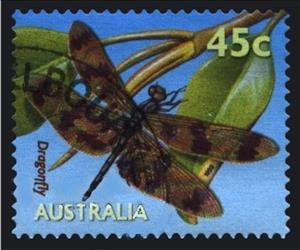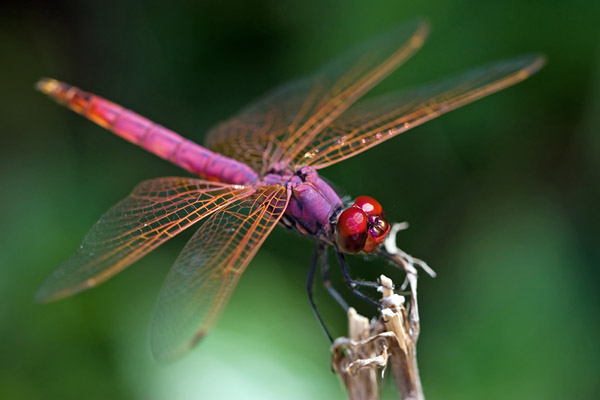Stamp: Graphic Flutterer (Rhyothemis graphiptera) (Australia 1999)
Graphic Flutterer (Rhyothemis graphiptera) (Australia 1999)
01 October (Australia ) within release Pond Life goes into circulation Stamp Graphic Flutterer (Rhyothemis graphiptera) face value 45 Australian cent
| Stamp Graphic Flutterer (Rhyothemis graphiptera) in catalogues | |
|---|---|
| Michel: | Mi:AU 1856IIC |
Stamp is horizontal format.
From miniature sheetAlso in the issue Pond Life:
- Souvenir Sheet - Pondlife Minisheet face value 2.80;
- Stamp - Roth's Tree Frog (Litoria rothii) face value 45;
- Stamp - Roth's Tree Frog (Litoria rothii) face value 45;
- Stamp - Graphic Flutterer (Rhyothemis graphiptera) face value 45;
- Stamp - Graphic Flutterer (Rhyothemis graphiptera) face value 45;
- Stamp - Sacred Kingfisher (Todiramphus sanctus) face value 45;
- Stamp - Sacred Kingfisher (Todiramphus sanctus) face value 45;
- Stamp - Magnificent Tree Frog (Litoria splendida) face value 45;
- Stamp - Magnificent Tree Frog (Litoria splendida) face value 45;
- Stamp - Northern Dwarf Tree Frog (Litoria bicolor) face value 50;
- Stamp - Northern Dwarf Tree Frog (Litoria bicolor) face value 50;
- Stamp - Javelin Frog (Litoria microbelos) face value 50;
- Stamp - Javelin Frog (Litoria microbelos) face value 50;
- Stamp - Sacred Kingfisher (Todiramphus sanctus) face value 45;
- Stamp - Magnificent Tree Frog (Litoria splendida) face value 45;
- Stamp - Northern Dwarf Tree Frog (Litoria bicolor) face value 50;
- Stamp - Javelin Frog (Litoria microbelos) face value 50;
- First Day Cover - Pond Life face value 280;
- First Day Cover - Kingfisher and Tree Frog (Self adhesive) face value 2*45;
- First Day Cover - Pond Life (Minisheet face value 280;
- Se-tenant - Roth's Tree Frog + Graphic Flutterer face value 2*45;
- Se-tenant - Sacred Kingfisher + Magnificent Tree Frog face value 2*45;
- Se-tenant - Northern Dwarf Tree Frog + Javelin Frog face value 2*50;
Stamp Graphic Flutterer (Rhyothemis graphiptera) it reflects the thematic directions:
Insects (from Latin insectum, a calque of Greek ἔντομον [éntomon], "cut into sections") are a class (Insecta) of hexapod invertebrates within the arthropod phylum that have a chitinous exoskeleton, a three-part body (head, thorax and abdomen), three pairs of jointed legs, compound eyes and one pair of antennae. They are the most diverse group of animals on the planet, including more than a million described species and representing more than half of all known living organisms. The number of extant species is estimated at between six and ten million, and potentially represent over 90% of the differing animal life forms on Earth. Insects may be found in nearly all environments, although only a small number of species reside in the oceans, a habitat dominated by another arthropod group, crustaceans. The life cycles of insects vary but most hatch from eggs. Insect growth is constrained by the inelastic exoskeleton and development involves a series of molts. The immature stages can differ from the adults in structure, habit and habitat, and can include a passive pupal stage in those groups that undergo 4-stage metamorphosis (see holometabolism). Insects that undergo 3-stage metamorphosis lack a pupal stage and adults develop through a series of nymphal stages. The higher level relationship of the Hexapoda is unclear. Fossilized insects of enormous size have been found from the Paleozoic Era, including giant dragonflies with wingspans of 55 to 70 cm (22–28 in). The most diverse insect groups appear to have coevolved with flowerin plants.
A dragonfly is a flying insect belonging to the infraorder Anisoptera below the order Odonata. About 3,000 extant species of dragonflies are known. Most are tropical, with fewer species in temperate regions. Loss of wetland habitat threatens dragonfly populations around the world. Adult dragonflies are characterised by a pair of large, multifaceted, compound eyes, two pairs of strong, transparent wings, sometimes with coloured patches, and an elongated body. Many dragonflies have brilliant iridescent or metallic colours produced by structural coloration, making them conspicuous in flight. An adult dragonfly's compound eyes have nearly 24,000 ommatidia each.


